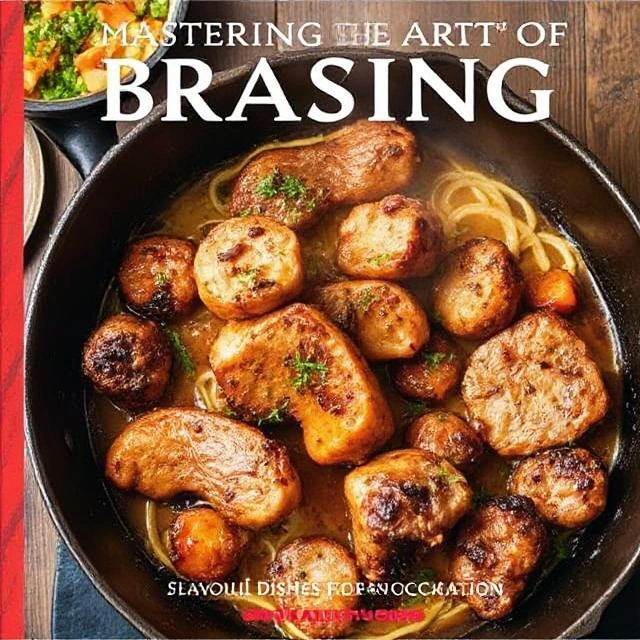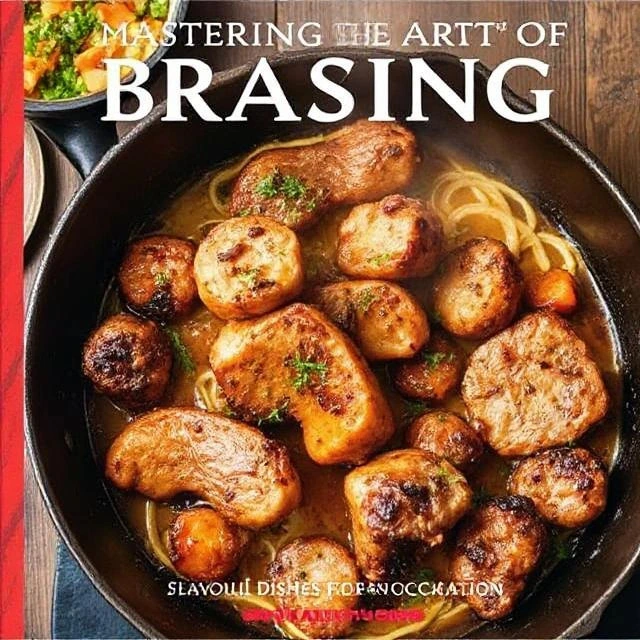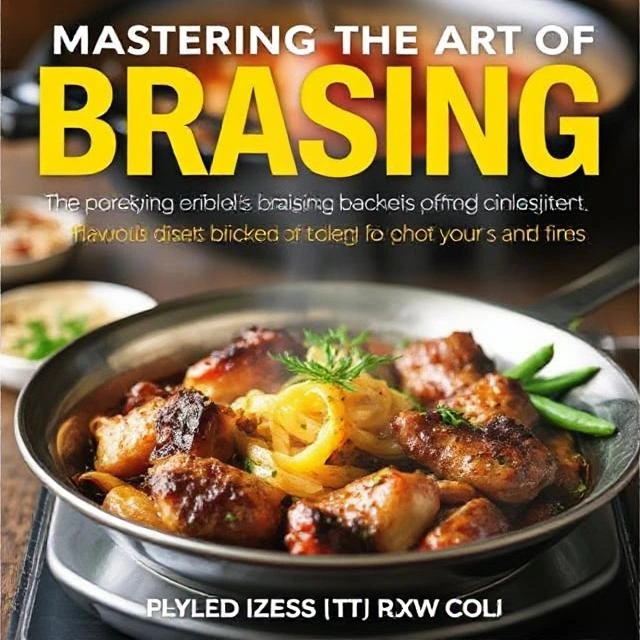Ever wondered how cooks turn tough cuts into tender braised dishes without fancy tools? Braising is the secret to making flavorful dishes that taste like they’re from a restaurant. This old cooking method uses low heat, liquid, and time to make ingredients like pork shoulder or beef short ribs tender. It’s perfect for any meal, whether you’re cooking for yourself or guests.
From Le Creuset Dutch ovens to foil-covered pans, you don’t need expensive gear for great results. A simple mix of aromatics, patience, and science can turn cheap ingredients into amazing dishes like Braised Beef Short Ribs or Pork Shanks Braised with Dark Beer. Even a $20 cut of meat can become a special meal when cooked right.
Key Takeaways

- Braising uses moist heat to break down tough collagen into gelatin for tender meat
- Brown braising creates complex flavors via the Maillard reaction during searing
- Inexpensive aluminum pans work as well as high-end cookware for most braises
- Proper liquid levels ensure even cooking and rich sauce development
- Leftover braising liquid makes versatile sauces or gravy bases
What Is Braising? Understanding This Transformative Cooking Method
Braising is a cooking method that uses both dry and moist heat. It turns tough ingredients into tender, rich dishes. This culinary technique is perfect for budget-friendly cuts. It has its roots in medieval kitchens and is now a key part of cuisines worldwide, like French coq au vin or Mexican carnitas.
The process begins with searing meat to keep juices in. Then, it’s cooked in liquid until done. This method has been around since the 12th century in European kitchens. It used heavy cast-iron pots back then. Today, it’s a global favorite, with flavors like ginger in Asian dishes and wine in French ones.
Braising vs. roasting: Roasting uses dry heat, while braising incorporates liquid for tenderizing Moist heat cooking vs. grilling: Braising’s slow process contrasts with grilling’s high-heat searing Stewing uses fully submerged ingredients, whereas braising leaves larger cuts partially covered
Low temperatures (300–350°F) help break down collagen into gelatin. This makes the sauces velvety. The slow flavor development comes from simmering aromatics like garlic and herbs with the main ingredient. This process takes 1.5–3 hours, showing how patience improves both texture and taste.
Pro tip: Choose cuts like chuck roast or oxtail for best results. Adjust liquid levels to one-third the pot’s depth to ensure even tenderizing without drowning ingredients.
The Science Behind Why Braising Creates Incredibly Tender Meat
Braising makes tough cuts into tender meats using science. It starts with collagen, a part of muscles. When cooked slowly, collagen turns into gelatin at 165°F.
This gelatin keeps meat moist and tender. It’s like a sponge for juices.
- Collagen breakdown softens fibers, turning sinewyiness into tenderness.
- Low heat prevents protein clumping, keeping meat juicy.
- Slow cooking allows flavor infusion from liquid and aromatics.
| Temperature Range | Process | Outcome |
|---|---|---|
| 165°F (74°C) | Collagen → Gelatin | Moisture retention |
| 180–190°F (82–88°C) | Proteins gently coagulate | Even texture |
| Over 195°F (90°C) | Muscles seize, moisture escapes | Dry, tough results |
High heat in grilling pushes juices out. Braising cooks slowly, breaking down tissues. The best temperature is 180–190°F for tender meat.
HexClad cookware cooks evenly, avoiding hot spots. This ensures perfect results every time.
Flavor infusion happens slowly, extracting goodness from bones and herbs. Unlike quick cooking methods, braising lets flavors blend well. Patience is key for dishes like osso buco, which are rich and delicious.
Essential Equipment for Perfect Braising Results
Choosing the right equipment is key to perfect braising every time. The right tools help keep heat steady and liquids bubbling at the right pace.
Dutch Ovens: The Ultimate Braising Vessel
“I love my cast iron Le Creuset pot because I can pop everything in and get it simmering on the stove before transferring to the oven. The heat transfer jump-starts the browning process,” says one home chef. This dual stovetop-to-oven capability makes enameled cast iron Dutch ovens like Le Creuset or Lodge favorites. Their thick walls maintain consistent dutch oven braising temperatures, while tight-fitting lids trap moisture for richresults. Sizes from 4 to 8 quarts suit everything from chicken thighs to pot roasts.
Braising Pans and Slow Cookers as Alternatives
- Braising pans with heavy bases and lids work well on stovetops but lack oven durability.
- Slow cookers excel attougher cuts like brisket, though they require 6-8 hours at 170-175°F compared to Dutch oven’s 300°F oven method.
- Electric pressure cookers cut times to 15-45 minutes via pressure cooking, but traditionalists prefer Dutch ovens for even heat distribution.
Additional Tools That Make a Difference
Invest in a meat thermometer to monitor internal temps—aim for 200°F for fall-apart tenderness. A fat separator helps clarify sauces after cooking. Use parchment paper to cover pans if lids are too large. Don’t forget tongs for turning meat and a slotted spoon to remove excess fat during. A silicone spatula scrapes fondue from the bottom, adding depth tosteps. For flavor, pair oils like canola with spice rubs containing garlic powder and cumin.
Selecting the Best Ingredients for Braising
Mastering braising begins with picking the right ingredients. These choices unlock rich flavors and tender textures. Let’s explore the key elements to enhance every dish.
Ideal Cuts for Meat Recipes
Tough cuts do well in slow, moist heat. Choose best cuts for braising like beef chuck, pork shoulder, or lamb shank. A 2-pound beef brisket, seasoned with 4 teaspoons of kosher salt, becomes incredibly tender when slow-cooked.
These cuts, full of collagen, turn into silky, savory meals. They’re perfect for hearty dishes.
Braising Vegetables: The Flavor Foundation
Braising vegetables add a lot of flavor. Onions, carrots, and celery are a good start. But don’t stop there. Waxy potatoes or bok choy (halved) cook fast and stay crisp-tender.
Pro tip: Slice vegetables thickly to avoid overcooking. Try braising vegetables like fennel or mushrooms for a unique twist. Most are done in under 20 minutes, keeping flavors bright.
Perfecting the Braising Liquid
The liquid is crucial for your dish. Use red wine for beef or chicken stock for poultry. A 3-cup base of milk or broth, plus aromatics like bay leaves, makes a rich sauce.
Avoid diced tomatoes; crushed or whole varieties are better. For a lighter finish, skim fat with a separator. Remember, the liquid should cover half the meat for even cooking.
Step-by-Step Guide to Braising Like a Professional Chef
Learning to how to braise meat is easy. Just follow these steps for tender, flavorful dishes every time.
- Prep and sear: Dry the meat, season with salt and pepper. Heat a Le Creuset Dutch oven with avocado oil until hot. Sear the meat 2-3 minutes per side. This step creates deep flavor through the Maillard reaction.
- Layer flavors: Add onions, carrots, and garlic. Pour in broth (not water) to halfway up the meat. Use red wine with beef and white wine with chicken.
- Cook low and slow: Cover and bake at 325°F. Let the meat braise gently. This method breaks down collagen into gelatin, making it tender.
- Monitor and adjust: Check every 30 minutes. Stir vegetables, turn meat, and add broth if needed. Keep it at a gentle simmer.
- Rest and finish: Let the meat rest 10-15 minutes. Skim fat, then thicken sauce. Taste and adjust seasoning.
- Braising tips: Use cuts like chuck roast or pork shoulder. Avoid acidic liquids like vinegar—they can toughen meat.
- For stewing alternatives, simmer ingredients fully submerged in liquid on the stove. Always use broth for richer flavor.
- Resting allows juices to redistribute, ensuring every bite stays moist.
Patience is key with braising. Follow these steps, and your dish will be tender and flavorful. Braising is forgiving as long as you cook low and slow and check occasionally.
Common Braising Mistakes and How to Avoid Them
Braising makes delicious flavorful stews if done correctly. Stay away from these common mistakes to enjoy the benefits of braising every time.
Temperature Management Errors
Too high a temperature can make meat tough. Keep the heat at 275–300°F for low and slow cooking. A hot pan can steam meat, making it dry. Use an oven-safe thermometer to check the temperature.

Liquid Level Problems
Getting the right amount of liquid is key for flavorful cooking techniques. Too little liquid can burn the pan, while too much can water down the flavor. Aim to have the liquid halfway up the meat. Adjust as needed:
- Add broth gradually if drying out
- Simmer uncovered to reduce excess liquid
Seasoning and Timing Mishaps
Season early and often. Not seasoning enough can make dishes taste flat. Epicurious suggests tasting and adjusting at each step—salt, herbs, and spices add depth. Be patient with tough cuts like chuck roast; they need 3–4 hours to tenderize. If meat is overcooked, remove it early and reduce the sauce separately.
| Mistake | Fix |
|---|---|
| Overcrowding the pan | Sear meat in batches |
| Skipping deglazing | Scrape browned bits into liquid for deeper flavor |
| Ignoring seasoning layers | Season meat before and during cooking |
With patience and precision, braising can be a braising recipes success. Adjust as you go, and enjoy the tender results.
Global Inspirations: Braised Dishes from Around the World
From European classics to Asian aromatic stews, braising recipes show how cultures make beloved dishes from simple ingredients. Slow cooking turns ingredients into cherished traditions.European traditions are seen in dishes like French coq au vin and Italian osso buco. These dishes combine red wine, herbs, and slow cooking for tender results. German sauerbraten, made with vinegar and spices, shows vinegar can make meat tender too. Asian cuisines turn braising into an art. Chinese red-braised pork uses soy sauce and star anise for deep flavor. Thai massaman curry and Japanese nikujaga blend spices and liquids for unique flavors. American braising includes New England pot roast and Southern collard greens. Tex-Mex chili con carne and Cajun gumbo show regional flavors. These braising recipes reflect the country’s diverse tastes.
| Region | Dish | Key Ingredients |
|---|---|---|
| Europe | Coq au Vin | Chicken, red wine, mushrooms |
| Asia | Red-Braised Pork | Pork belly, soy sauce, star anise |
| America | Chili Con Carne | Ground beef, tomatoes, beans |
From Parisian bistros to Tokyo izakayas, braising is a universal language. Try global braising recipes to see how meat cooking becomes an adventure in every pot.
One-Pot Wonders: Versatile Braising Recipes for Any Occasion

Make your kitchen routine better with one-pot cooking. These braised recipes offer rich, flavorful cooking method results. They’re great for cozy weeknight dinners or dinner parties. Over 100 braised dishes have been tested, with 12 rated 4.6 stars or higher.
“A bonus that the [braised dishes] taste better chilled and reheated.”
Here are top-rated picks to try:
- Mushroom Ragu: A 5-star braised recipes favorite, this vegetarian option earns praise for its silky texture and 615 ratings. Ready in 35 minutes, it’s perfect for veggie-forward meals.
- Chickpea & Broccoli Alfredo Skillet: A creamy, 4.8-star one-pot cooking option needing just 30 minutes. Dairy-free swaps are noted in 4 recipes like this.
- White Chicken Chili: A 4.5-star comfort food hit, ready under an hour. Ideal for batch cooking (10% of recipes suggest freezing).
| Recipe | Cook Time | Rating |
|---|---|---|
| Mushroom Ragu | 35 mins | 4.8/5 |
| Cacio E Pepe White Beans Skillet | 15 mins | 4.7/5 |
| One-Pot Tortellini & Greens | 20 mins | 4.6/5 |
| Honey Garlic Glazed Salmon | 25 mins | 4.5/5 |
Many braised recipes pair well with seasonal ingredients—like sweet potatoes or winter greens. Need vegan options? 2 recipes here include plant-based swaps. With prep times averaging 15–35 minutes, these dishes cut cleanup while maximizing flavor. Experiment with ingredient swaps (4 recipes suggest this) to suit dietary needs. From weeknight dinners to holiday menus, these braised dishes prove that slow-cooked meals don’t require extra effort.
Conclusion: Embracing the Slow and Flavorful Art of Braising
Braising is a slow cooking method that turns tough cuts into tender meat. It uses low heat and moist air to break down fibers. This makes the meat melt in your mouth. You can use a Le Creuset Dutch oven or an Instant Pot to do it.
Using high-quality ingredients like Wagyu short ribs makes a big difference. They are tender because of their marbling. You can get a 20% discount with code LUCKYWAGYU20. Even cheaper cuts like beef chuck become tender when braised.
Slow cooking is great for using leftovers. Braised dishes like pot roast get even better after chilling. You can turn them into hash, stews, or sandwiches. Recipes like beef and mushroom stroganoff show how easy it is to reuse flavors.
Learning braising techniques means enjoying dishes that are worth the effort. Start with simple recipes like pot roast. Then try global twists like Korean kalbi or French daube. Each dish is a labor of love, perfect for any occasion.
Slow cooking is more than a method; it’s a way to make meals that nourish and impress. With every braise, you’re not just cooking; you’re building skills. Your kitchen’s next masterpiece is waiting, one simmer at a time.
FAQ
What is braising, and how does it differ from other cooking methods?
Braising is a cooking method that uses slow cooking in a small amount of liquid. First, you sear the food. Then, you cook it in moist heat. This makes tougher cuts of meat tender and infuses flavors.
Why does braising create such tender meat?
The slow cooking breaks down collagen in meat, turning it into gelatin. This makes the meat tender. The gentle heat also enhances flavors by infusing them into the meat.
What equipment do I need for successful braising?
A Dutch oven is best for braising because it holds heat well. You can also use braising pans, slow cookers, or pressure cookers. Having tools like meat thermometers and fat separators helps too.
What are the best cuts of meat for braising?
The best cuts for braising are tough, collagen-rich options. Examples include chuck roast, brisket, pork shoulder, and lamb shanks. They become tender and flavorful through slow cooking.
Can I braise vegetables as well?
Yes! Vegetables like carrots, potatoes, and root vegetables are great for braising. They soak up the flavors of the braising liquid and become tender.
How do I create flavorful braising liquids?
To make flavorful braising liquids, use stocks, wines, broths, or water with aromatics. Add garlic, onions, herbs, and spices. This will enhance the flavors of your dish.
What are some common mistakes to avoid when braising?
Avoid cooking at too high a temperature, which can make meat tough. Also, make sure you have enough liquid. Don’t forget to taste and adjust seasonings during cooking.
How can I ensure my braised dish is successful?
Follow a step-by-step process for preparation, searing, and managing the braising liquid. Keep an eye on temperature and timing. Braising is forgiving, so adjust as needed.
Are there vegetarian options for braising?
Yes! You can make vegetarian and vegan dishes by braising mushrooms, squash, lentils, and beans. They offer rich flavors and satisfying results.
What are some popular global braised dishes?
Explore global dishes like coq au vin and osso buco from Europe. Asian options include red-braised pork and galbi jjim. American favorites include pot roast and braised greens.
Source Links
- A foolproof guide to braising
- How to Braise (Easily Master the Cooking Method + Recipes)
- The Transformative Power of Braising Vegetables
- The Reason Why “Braising” Makes Food Taste So Good
- Mastering Stewing and Braising: Techniques and Tips
- Science of Cooking: Braising Makes A Tough Cut Tender | Exploratorium
- Braising Meat 101: How To Braise Meat Like a Pro by HexClad Cookware
- Braised Beef – The Science Behind the Method | Nebraska Star Beef®
- How to Perfect the Art of Braising | RICARDO
- How to Braise for the Most Fall-Apart-Tender Meats Ever
- The Best Braising Liquids for Bigger, Bolder Flavor
- 🥘 Master the Art of Braising: Essential Tips for Beginners!
- Sohla’s Golden Rules for Braising
- How to Braise Meat So It’s Tender and Juicy
- How to Braise Meat Technique with Michelin Chef + Video
- 13 Mistakes You’re Making When Braising Meat (And How To Fix Them) – Tasting Table
- Braise On! How to Transform Tough Cuts of Meat into a Feast, No Recipe Required
- Mistakes You’ve Been Making When Braising Meat – Mashed
- Braised and infused: 10 flavoursome stovetop recipes for grey Australian winter weekends
- Your Guide To Braising With Wine | Alcohol Professor
- Chicken Yassa (Senegalese Braised Chicken With Caramelized Onions)
- One-pot recipes
- Don’t Fill Up The Kitchen Sink—These 60 One-Pan Dinners Are Here To Save Your Weeknights
- Short Ribs Decoded: Tips for Braising and Grilling
- Mastering the Art of Beef Chuck Roast Recipes and Beyond
- Ultimate Braised Beef Noodles Recipe: Tips and Regional Flavors – likelikedriveinn.com